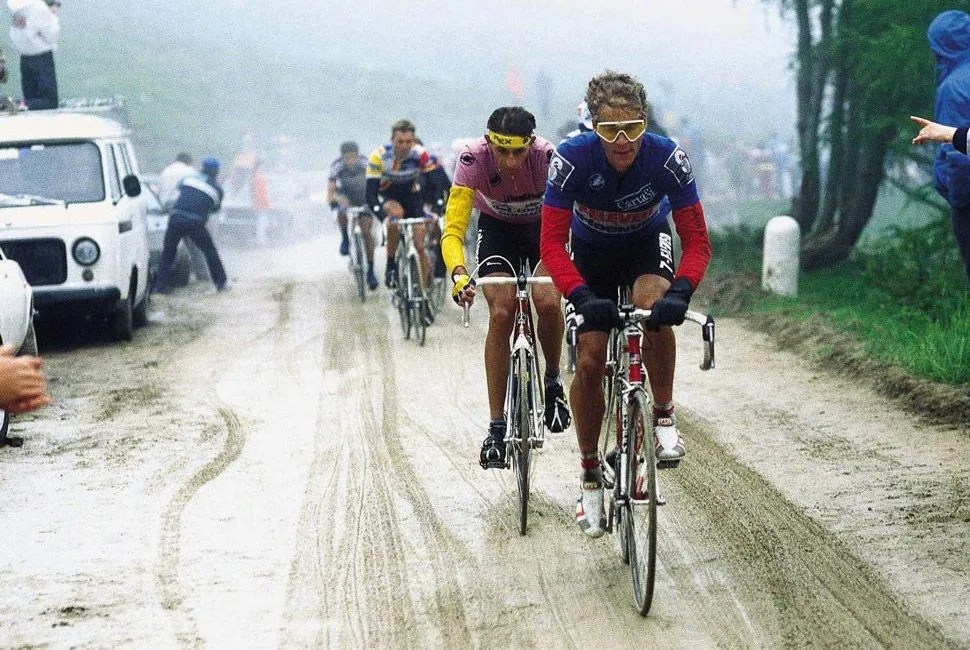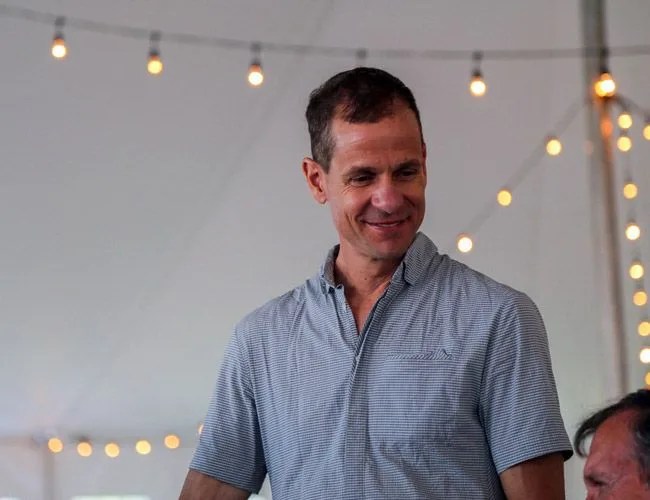On June 5, 1988, a snowstorm almost 9,000 feet up in the Italian Alps sent professional cyclists to the side of the road, into support cars and, in some cases, to the hospital with hypothermia. In one of the Giro d’Italia‘s best-remembered moments, American Andy Hampsten — clad in oversized Oakleys, a wool beanie and neoprene diving gloves — rode through the blizzard in the Gavia Pass aggressively, later becoming the first American to win the race since it began in 1909. That distinction still stands today. Hampsten retired from professional cycling as one of the sport’s greatest climbers in 1997, but continued to explore his passion for cycling by starting a frame-building business with his brother, Steve, and running Cinghiale Cycling Tours in Italy, where he spends part of the year. We met Hampsten at the inaugural Eroica California this year, and later, caught up with him about his famous Giro victory, the allure of steel bikes and the state of professional cycling.
Q. I want to jump into some of the history stuff first. Back to 1987 when you went from La Vie Claire to 7-Eleven. I’m curious what some of the differences between American and European cycling were then.
A. At the time there was a huge difference. In ’86 with La Vie Claire, I was with the best team in the world. And we had very famous problems having Hinault on the team. So that’s part of the reason I went to 7-Eleven. It was a pretty small team, and unproven compared to big European teams. But that’s exactly why I wanted to race with it. I wanted to be with Americans. It was organized well and without having a lot of clout behind it. I knew that it would be a great atmosphere for me to race in. And it was certainly a risk going from arguably the best team in Europe to a small American team. But since I’d already raced with them a little bit in 1985, it was a pretty fun risk for me to take.
Q. Why didn’t you want to race with a European team anymore?
A. Well, that wasn’t it exactly. In 1986, I raced with a lot of the La Vie Claire team, and it was — it was just hard to manage, and I didn’t enjoy it as much as I thought I would. So it was more interesting for me to be with an American team, even though it wasn’t as good of a team.
Q. And when you say difficult to manage we’re talking about the Hinault-LeMond rivalry? That’s a bit of a long story.
A. It’s a long, great story. It’s well covered in the Slaying the Badger movie and book. All teams are fun to race with when you’re a gang of brothers against the whole world. And with the La Vie Claire, even though everyone was a superstar and we won everything, it just wasn’t much fun. Looking back on it is fantastic, but at the time it wasn’t much fun, at least for my personality. I’d rather be with a smaller, tighter, more cohesive group of racers than be on a superstar team that didn’t get along.
Q. Since we’re talking about history I’d like to spend a little time talk about the old bikes you rode. One thing that was mentioned at Eroica is that these classic bikes with shifters on the down tubes help you better understand how hard cycling is and allows you to get in touch with cycling’s history. Even some of the bikes that you and your brother make are sort of styled that way. Is it more than just nostalgia? Is there something about these old steel frames?
A. Well, they’re beautiful, if that’s where your eye leads you. I didn’t bring one of my bikes [to Eroica California], so I borrowed a 1950s English bike named Reg Harris — he was a frame builder and World Champion. It was fantastic. It was so much fun on pavement and on those dirt roads that I was kind of shocked. It had really narrow bars, which is nothing like a modern bike; it was heavy, it had horrible gears (I used to race with the same brand Simplex gears). It was so bad when I raced on them. But the mechanic at the bike shop, Wally’s, they did such a good job taking care of the bike that it shifted beautifully.
The day before the ride, I went to my favorite winery in the area. Between obligations I rode the bike out — not in my cycling clothes, just street clothes — tasted a bunch of wine until it got a little bit late, and then I jumped on the bike and rode mostly downhill 40 minutes back to Paso Robles. And the bike couldn’t have handled better. Which just proves to me that, I think bike design had really been figured out about 80 or 100 years ago.
Materials change, wheels change. Things get so much lighter, brakes work so much better now. But as far as being on a bike and having it just go instinctively where I want to go, through curves when — and to be honest, I had too much wine — it couldn’t have been a more comfortable bike. My brother and I run Hampsten Cycles, and we custom make bikes out of titanium and steel and a little bit of carbon fiber. And it’s really interesting keeping up on new material, and I love new brakes and gears that work so well, but it’s pretty fun being in cycling and just realizing how great bikes have been for 100 years now.

